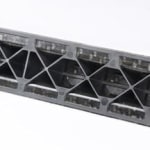 Lanxess currently is expanding its leading position in fiber-reinforced thermoplastic composites for lightweight construction applications.
Lanxess currently is expanding its leading position in fiber-reinforced thermoplastic composites for lightweight construction applications. Extensive investments already have been made, in areas ranging from the development of custom materials and simulation methods, and the determination of characteristic material values to component testing. Further, project management is being expanded to support both Lanxess customers and their customers in developing innovative composite components. “In view of the trend towards lightweight electric cars and lightweight, fuel-saving motor vehicles, we are concentrating intensively on nylon composite sheet hybrid technology based on polyamide.
Compared to pure metal, or metal/plastic hybrid designs, this technology offers great potential for saving on component weight,” explains Hartwig Meier, head of Product and Applications Development in the Semi-Crystalline Products business unit at Lanxess.
Lanxess's expertise in thermoplastic lightweight construction solutions builds in part on the plastic/metal hybrid technology used to fabricate, for example, front ends, brake pedals and pedal brackets. Hybrid components are usually 20 to 30 percent lighter than their pure steel counterparts while offering the same performance. Even more weight can be eliminated if the sheet metal is replaced by lightweight polyamide nylon composite sheet reinforced with continuous fibers, shaped in accordance with hybrid technology and back-injected with polyamide. This cuts component weight by another 10 percent over aluminum hybrid designs. Even greater savings are achieved compared to hybrid components with steel inserts. “We see great potential for nylon composite sheet hybrid technology in the production of door sills, B pillars and seat cross-members,” Meier says.
Lanxess is now capable of simulating all the process steps in nylon composite sheet hybrid technology. Recently, the company succeeded in simulating the extremely complex processes involved in shaping nylon composite sheet.
“Now we can not only calculate locally varying fiber alignments in a molded nylon composite sheet, we can also determine when multiple folds will form during shaping, how the semi-finished product is best positioned in the mold and the limit conditions for thermoforming,” Meier explains. The locally varying fiber alignments must be known input parameters for mechanical structural analysis in integrative simulation, so that anisotropic material behavior can be taken into account in the component design.
Lanxess conducts its own, complex experiments to determine the characteristic material values required to simulate various process steps and analyze mechanical structure. For example, the recent investments included a large tensile testing machine to determine, for instance, crash-relevant characteristic material data for polyamide nylon hybrid composites in accelerated tensile strength at break experiments.
“In collaborative projects, we incorporate these characteristic values and subsequent calculations in the component design process. These services are part of HiAnt, our competence brand under which we have pooled our expertise in materials, design, simulation and process engineering,” says Meier.
The customer service associated with HiAnt includes material selection support, manufacturing cost estimation, CAE calculations, mold filling, warpage minimization, mold construction, component testing and assistance in starting up full-scale production.



